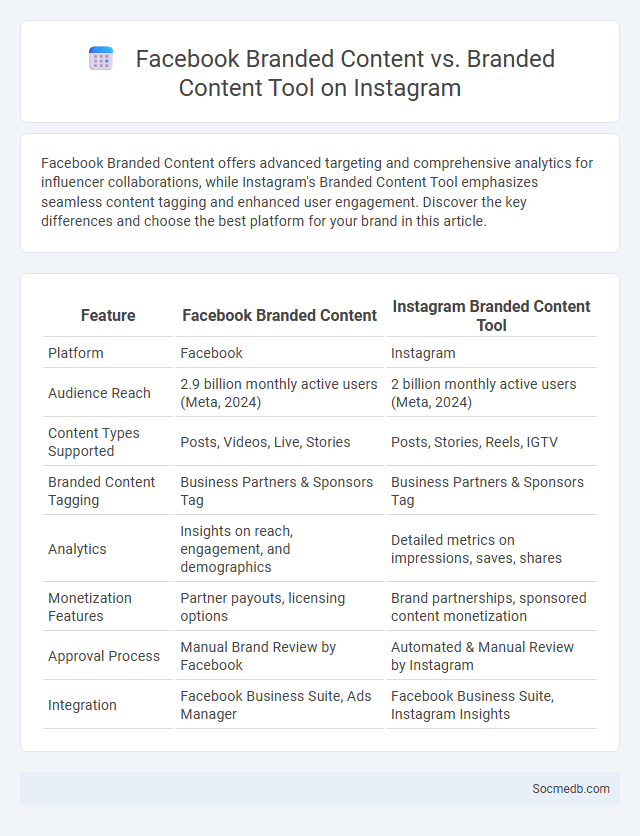
Photo illustration: Facebook Branded Content vs Branded Content Tool Instagram
Facebook Branded Content offers advanced targeting and comprehensive analytics for influencer collaborations, while Instagram's Branded Content Tool emphasizes seamless content tagging and enhanced user engagement. Discover the key differences and choose the best platform for your brand in this article.
Table of Comparison
| Feature | Facebook Branded Content | Instagram Branded Content Tool |
|---|---|---|
| Platform | ||
| Audience Reach | 2.9 billion monthly active users (Meta, 2024) | 2 billion monthly active users (Meta, 2024) |
| Content Types Supported | Posts, Videos, Live, Stories | Posts, Stories, Reels, IGTV |
| Branded Content Tagging | Business Partners & Sponsors Tag | Business Partners & Sponsors Tag |
| Analytics | Insights on reach, engagement, and demographics | Detailed metrics on impressions, saves, shares |
| Monetization Features | Partner payouts, licensing options | Brand partnerships, sponsored content monetization |
| Approval Process | Manual Brand Review by Facebook | Automated & Manual Review by Instagram |
| Integration | Facebook Business Suite, Ads Manager | Facebook Business Suite, Instagram Insights |
Understanding Branded Content: Definition and Importance
Branded content integrates promotional messages seamlessly within engaging storytelling to enhance brand awareness and consumer trust. This type of content leverages social media platforms' vast reach, creating authentic connections that drive user engagement and foster loyalty. Understanding branded content empowers you to craft compelling campaigns that resonate with your target audience and boost your brand's visibility.
Facebook Branded Content: Features and Benefits
Facebook Branded Content enables creators and businesses to collaborate by tagging partners directly in posts, enhancing transparency and boosting audience trust. This feature provides detailed insights and analytics on branded content performance, allowing you to measure engagement and optimize campaigns effectively. Leveraging Facebook Branded Content helps increase brand visibility and drives authentic user interaction, maximizing your marketing ROI.
Instagram Branded Content: Unique Capabilities
Instagram Branded Content offers unique capabilities that allow creators and brands to collaborate transparently through native integrations like paid partnerships, boosting authenticity and trust. You can leverage features such as product tagging and exclusive insights to optimize campaign performance and directly connect with target audiences. These tools enhance engagement by seamlessly blending promotional content with organic storytelling on the platform.
Facebook Branded Content Tool: How It Works
Facebook Branded Content Tool enables creators and businesses to tag business partners directly in posts, enhancing transparency and boosting brand visibility. This feature allows brands to sponsor content, track performance metrics, and engage with targeted audiences more effectively. By leveraging Facebook's native integration, branded content campaigns gain authenticity and increased reach through organic user interactions.
Instagram Branded Content Tool: Key Functionalities
Instagram Branded Content Tool enables creators and businesses to tag brand partners directly in posts, enhancing transparency and trust with your audience. This functionality allows seamless collaboration by providing insights on post performance, including reach and engagement metrics, critical for measuring campaign success. With the tool's integration into Instagram's ecosystem, managing sponsored content becomes streamlined, ensuring compliance with advertising policies and boosting brand visibility.
Differences Between Facebook and Instagram Branded Content
Facebook branded content allows you to create detailed posts with links, long descriptions, and a broader audience targeting, making it ideal for in-depth brand storytelling. Instagram branded content emphasizes visual storytelling with high-quality images and short captions, leveraging influencer partnerships to engage younger demographics. Your choice between these platforms depends on the desired engagement style and audience preference for content consumption.
Branded Content Policies: Facebook vs Instagram
Facebook and Instagram enforce distinct Branded Content Policies tailored to their platforms, requiring creators to disclose partnerships transparently using branded content tags. Facebook mandates clear sponsor disclosures in compliance with FTC guidelines, emphasizing authenticity and user trust, while Instagram enforces similar rules but integrates branded content tools directly within the app for seamless tagging. Both platforms prioritize transparency to protect consumers and ensure advertisers adhere to policies preventing deceptive marketing practices.
Measuring Performance: Facebook vs Instagram Analytics
Facebook Analytics offers comprehensive metrics such as user demographics, page engagement, and conversion tracking, providing detailed insights into audience behavior and advertising effectiveness. Instagram Analytics emphasizes real-time data on follower growth, story interactions, and hashtag performance, which is crucial for visual content optimization and influencer marketing strategies. Comparing both platforms, marketers benefit from Facebook's robust demographic data and Instagram's engagement-focused metrics to tailor campaigns and measure ROI accurately.
Choosing the Right Platform for Your Branded Content
Selecting the right social media platform for branded content depends on understanding your target audience's demographics, behaviors, and preferences on each channel. Platforms like Instagram and TikTok are ideal for visually-driven, younger demographics, while LinkedIn caters to B2B content and professional networks. Aligning your brand message with the platform's content style and engagement patterns maximizes reach and impact.
Best Practices for Creating Effective Branded Content on Facebook and Instagram
Creating effective branded content on Facebook and Instagram requires understanding platform algorithms and user engagement patterns to maximize reach and interaction. Your visuals should be high-quality and consistent with brand identity, while captions need to be concise, compelling, and infused with relevant keywords to boost discoverability. Leveraging features like Instagram Stories, Facebook Live, and interactive polls can enhance audience connection and foster authentic community engagement.
 socmedb.com
socmedb.com